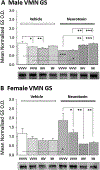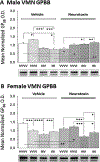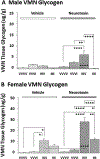Hindbrain catecholamine regulation of ventromedial hypothalamic nucleus glycogen metabolism during acute versus recurring insulin-induced hypoglycemia in male versus female rat
- PMID: 33997825
- PMCID: PMC8114938
- DOI: 10.1016/j.endmts.2021.100087
Hindbrain catecholamine regulation of ventromedial hypothalamic nucleus glycogen metabolism during acute versus recurring insulin-induced hypoglycemia in male versus female rat
Abstract
Ventromedial hypothalamic nucleus (VMN) glycogen metabolism affects local glucoregulatory signaling. The hindbrain metabolic-sensitive catecholamine (CA) neurotransmitter norepinephrine controls VMN glycogen phosphorylase (GP)-muscle (GPmm) and -brain (GPbb) type expression in male rats. Present studies addressed the premise that CA regulation of hypoglycemic patterns of VMN glycogen metabolic enzyme protein expression is sex-dimorphic, and that this signal is responsible for sex differences in acclimation of these profiles to recurrent insulin-induced hypoglycemia (RIIH). VMN tissue was acquired by micropunch-dissection from male and female rats pretreated by caudal fourth ventricular administration of the CA neurotoxin 6-hydroxydopamine (6OHDA) before single or serial insulin injection. 6-OHDA averted acute hypoglycemic inhibition of VMN glycogen synthase (GS) and augmentation of GPmm and GPbb protein expression in males, and prevented GPmm and -bb down-regulation in females. Males recovered from antecedent hypoglycemia (AH) exhibited neurotoxin-preventable diminution of baseline GS profiles, whereas acclimated GPmm and -bb expression in females occurred irrespective of pretreatment. RIIH did not alter VMN GS, GPmm, and GPbb expression in vehicle- or 6-OHDA-pretreated animals of either sex. VMN glycogen content was correspondingly unchanged or increased in males versus females following AH; 6-OHDA augmented glycogen mass in AH-exposed animals of both sexes. RIIH did not alter VMN glycogen accumulation in vehicle-pretreated rats of either sex, but diminished glycogen in neurotoxin-pretreated animals. AH suppresses baseline GS (CA-dependent) or GPmm/GPbb (CA-independent) expression in male and female rats, respectively, which corresponds with unaltered or augmented VMN glycogen content in those sexes. AH-associated loss of sex-distinctive CA-mediated enzyme protein sensitivity to hypoglycemia (male: GS, GPmm, GPbb; female: GPmm, Gpbb) may reflect, in part, VMN target desensitization to noradrenergic input.
Keywords: 6-hydroxydopamine; Glycogen phosphorylase; Glycogen synthase; Recurrent insulin-induced hypoglycemia; Sex differences; Ventromedial hypothalamic nucleus.
Conflict of interest statement
Declaration of Competing Interest The authors declare that they have no conflict of interest.
Figures





Similar articles
-
Glycogen phosphorylase isoenzyme GPbb versus GPmm regulation of ventromedial hypothalamic nucleus glucoregulatory neurotransmitter and counter-regulatory hormone profiles during hypoglycemia: Role of L-lactate and octadecaneuropeptide.Mol Cell Neurosci. 2023 Sep;126:103863. doi: 10.1016/j.mcn.2023.103863. Epub 2023 May 31. Mol Cell Neurosci. 2023. PMID: 37268282 Free PMC article.
-
Glycogen Phosphorylase Isoform Regulation of Ventromedial Hypothalamic Nucleus Gluco-Regulatory Neuron 5'-AMP-Activated Protein Kinase and Transmitter Marker Protein Expression.ASN Neuro. 2021 Jan-Dec;13:17590914211035020. doi: 10.1177/17590914211035020. ASN Neuro. 2021. PMID: 34596459 Free PMC article.
-
Sex-Specific recurrent insulin-induced hypoglycemia (RIIH) effects on ventromedial hypothalamic nucleus astrocyte metabolic sensor expression and glycogen metabolism.Neuroscience. 2025 Aug 1:S0306-4522(25)00825-5. doi: 10.1016/j.neuroscience.2025.07.042. Online ahead of print. Neuroscience. 2025. PMID: 40754129
-
Norepinephrine Regulation of Ventromedial Hypothalamic Nucleus Astrocyte Glycogen Metabolism.Int J Mol Sci. 2021 Jan 13;22(2):759. doi: 10.3390/ijms22020759. Int J Mol Sci. 2021. PMID: 33451134 Free PMC article. Review.
-
Norepinephrine Regulation of Ventromedial Hypothalamic Nucleus Metabolic-Sensory Neuron 5'-AMP-Activated Protein Kinase Activity: Impact of Estradiol.Int J Mol Sci. 2020 Mar 16;21(6):2013. doi: 10.3390/ijms21062013. Int J Mol Sci. 2020. PMID: 32188013 Free PMC article. Review.
References
-
- Alhamami HN, Uddin MM, Mahmood ASMH, Briski KP, 2018. Lateral but not medial hypothalamic AMPK activation occurs at the hypoglycemic nadir in insulin-injected male rats: Impact of caudal dorsomedial hindbrain catecholamine signaling. Neuroscience 379, 103–114. - PubMed
-
- Bélanger M, Allaman I, Magistretti PJ, 2011. Brain energy metabolism: focus on astrocyte-neuron metabolic cooperation. Cell Metab 14, 724–738 . - PubMed
-
- Bheemanapally K, Ibrahim MMH, Briski KP, 2020. Combinatory high-resolution microdissection/ultra performance liquid chromatographic-mass spectrometry approach for small tissue volume analysis of rat brain glycogen. J. Pharmaceut. Biomed. Anal 178, 112884. doi: 10.1016/j.jpba.2019.112884 . - DOI - PMC - PubMed
-
- Briski KP, Marshall ES, Sylvester PW, 2001. Effects of estradiol on glucoprivic trans-activation of catecholaminergic neurons in the female rat caudal brainstem. Neuroen-docrinology 73, 369–377 . - PubMed
Grants and funding
LinkOut - more resources
Full Text Sources
Other Literature Sources
